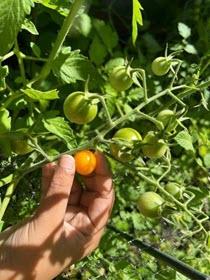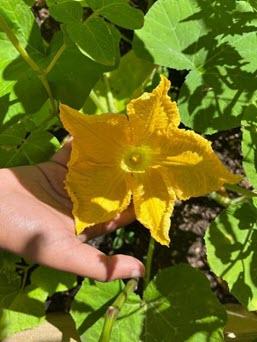The Latest Dirt - July 2022
School Garden Readiness for the New School Year
By Soubarna Mishra
Summer is the time when gardens respond vigorously to all the elements— sunlight, temperature, water and soil nutrients—and undergo rapid transformations. There is something new to see every day. The little seedlings planted in late spring or early summer transform into “overgrown forests.” The plants are lush from well-watered and compost-enhanced soils, and start producing their fruit.

While some schools have well-established systems in place to manage their gardens during school breaks, others struggle to keep their plants alive and weeds at bay. The children, teachers and parents who take on the responsibility of supporting school gardens during summer learn valuable lessons on gardening, especially on watering and pest deterrence.
The greatest joy to children in the garden is discovering and observing new creatures that emerge and make the garden their home. It is exciting for them to see varieties of wildlife sharing a small garden space. Some are easy to love, like ladybugs, butterflies and hummingbirds. Others are challenging to welcome, like bees, wasps, ants or earwigs that sting, bite, or look scary. Children are delighted to watch creatures that adults consider pests, such as caterpillars, snails and squirrels. School gardens are not perfect, and that’s the way they serve best. They are a place to experiment, solve problems, and simply observe different things.
Before schools re-open, members of active school gardens start planning activities to get the gardens ready for the new school year. Those that are inactive, or looking for new ideas, may seek advice and direction. Some schools are reaching out to UC Master Gardener volunteers for advice during summer break. There are many exciting opportunities to take on.

If you get a request for advice, get in touch with one of the School Garden co-leads. They can share valuable insights, provide important guidelines on how to volunteer around minors, and add you to the School Garden Program group on UC ANR Collaborative Tools. There, you can post your reports and get inspired by reading reports posted by others. The school garden co-leads can also help you understand how to plan your projects and activities.
Next, set up an appointment to visit the school garden site for an initial assessment. During this visit, record your observations on the site’s unique microclimate and requirements. The scope of the project and CoCoMG involvement will be based on the information gathered during this initial assessment. This will help you decide what you can do, how much time and effort you can commit, and whether you should reach out to other CoCoMG volunteers for help. Share your findings in a report in the School Gardens Collaborative Tools discussion section. Remember, every school garden has unique needs and challenges. I always visit the school garden site, talk to the school staff and students, and then offer advice or recommendations, based on observing the site and listening to their needs.
Volunteering for school gardens can be fun and rewarding. Several schools want your help for their gardens. Some of them are College Park High, Tice Creek Elementary, Walnut Heights Elementary, and Parkmead Elementary, all located in Central County. There are also schools in East and West County that need our guidance. Or, if you prefer to help remotely, you’ll find several opportunities there too.
Just email me at soubarna@gmail.com to begin volunteering for any of the schools listed above. For more information on the School Gardens project and other ways to volunteer, reach out to me or one of my other co-leads, Pam at paustin26@yahoo.com or Kate at austinandkate@gmail.com.
